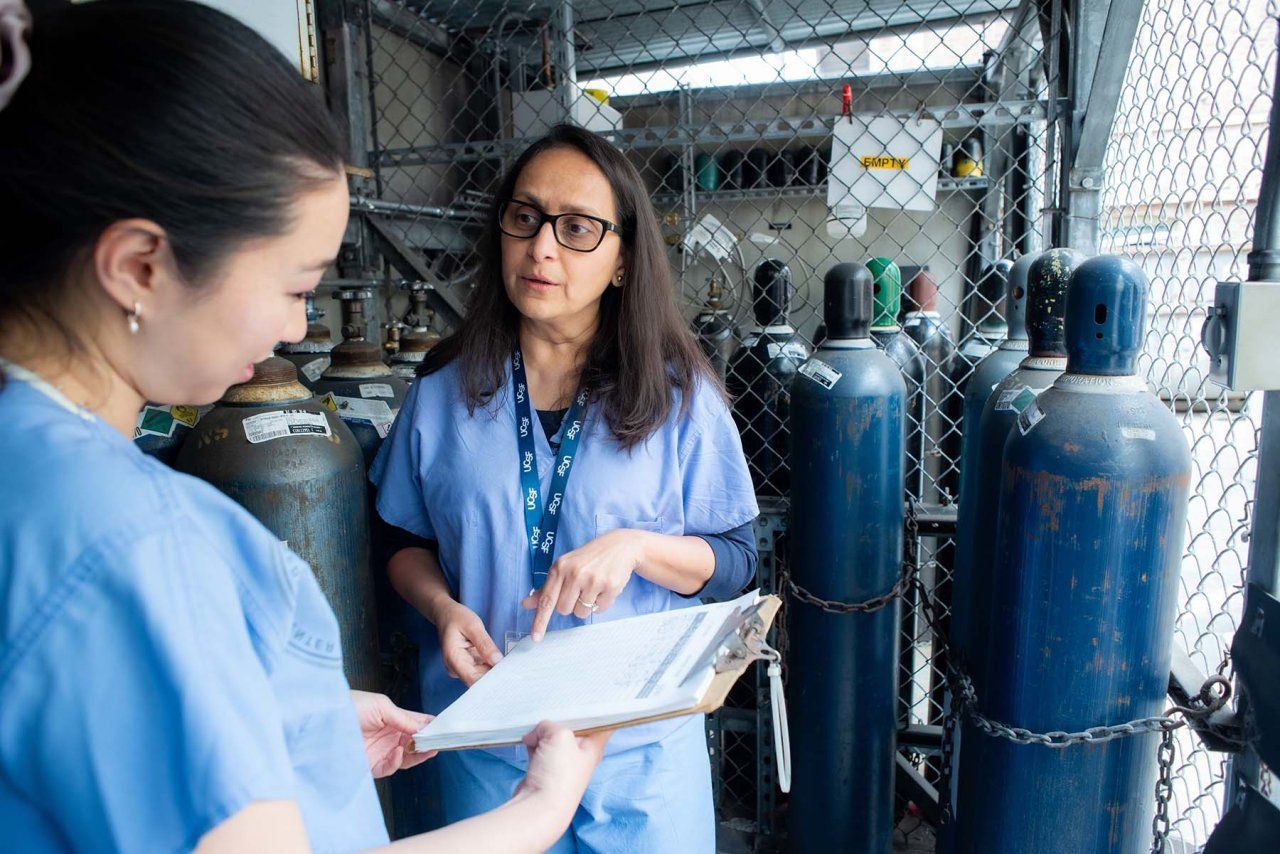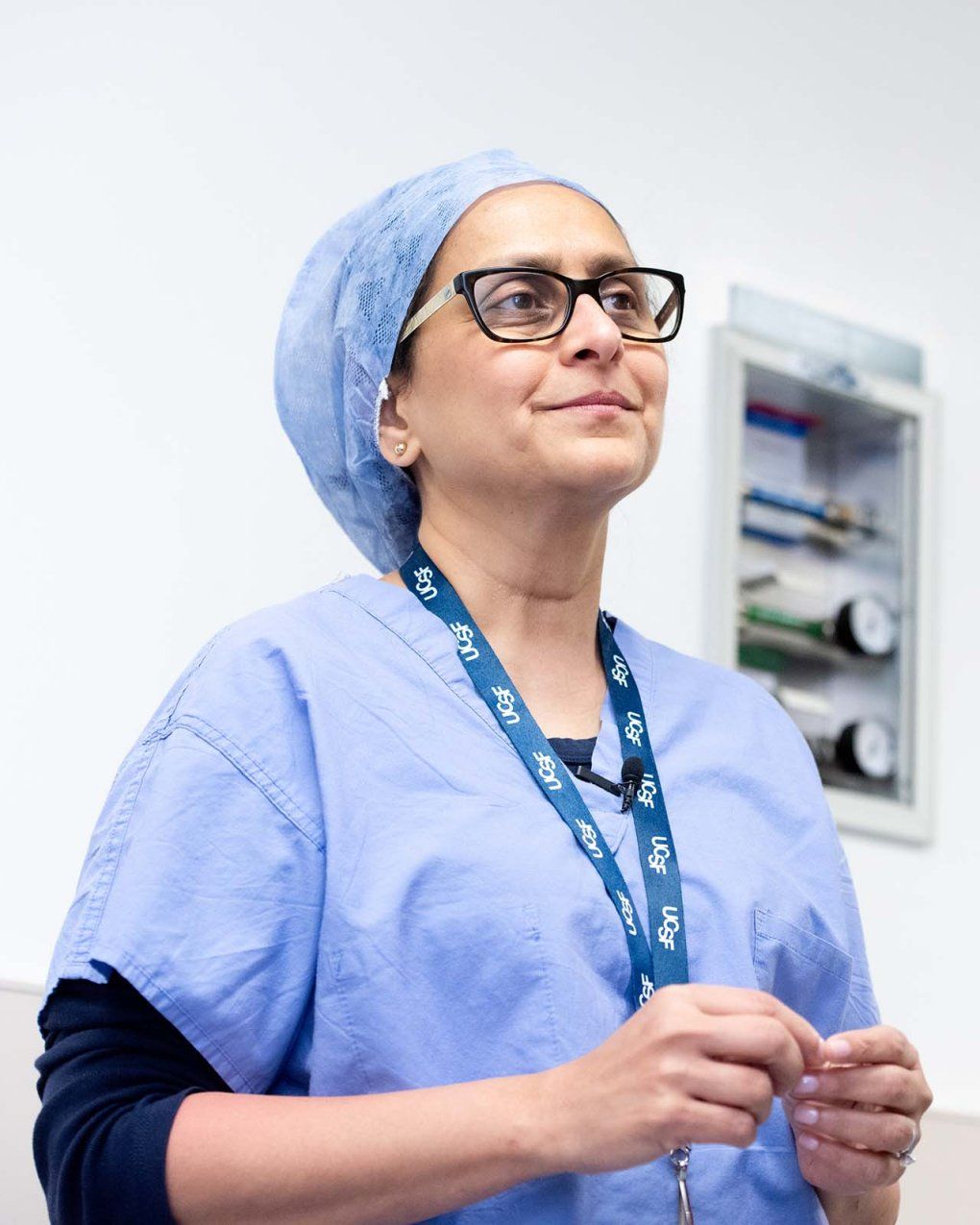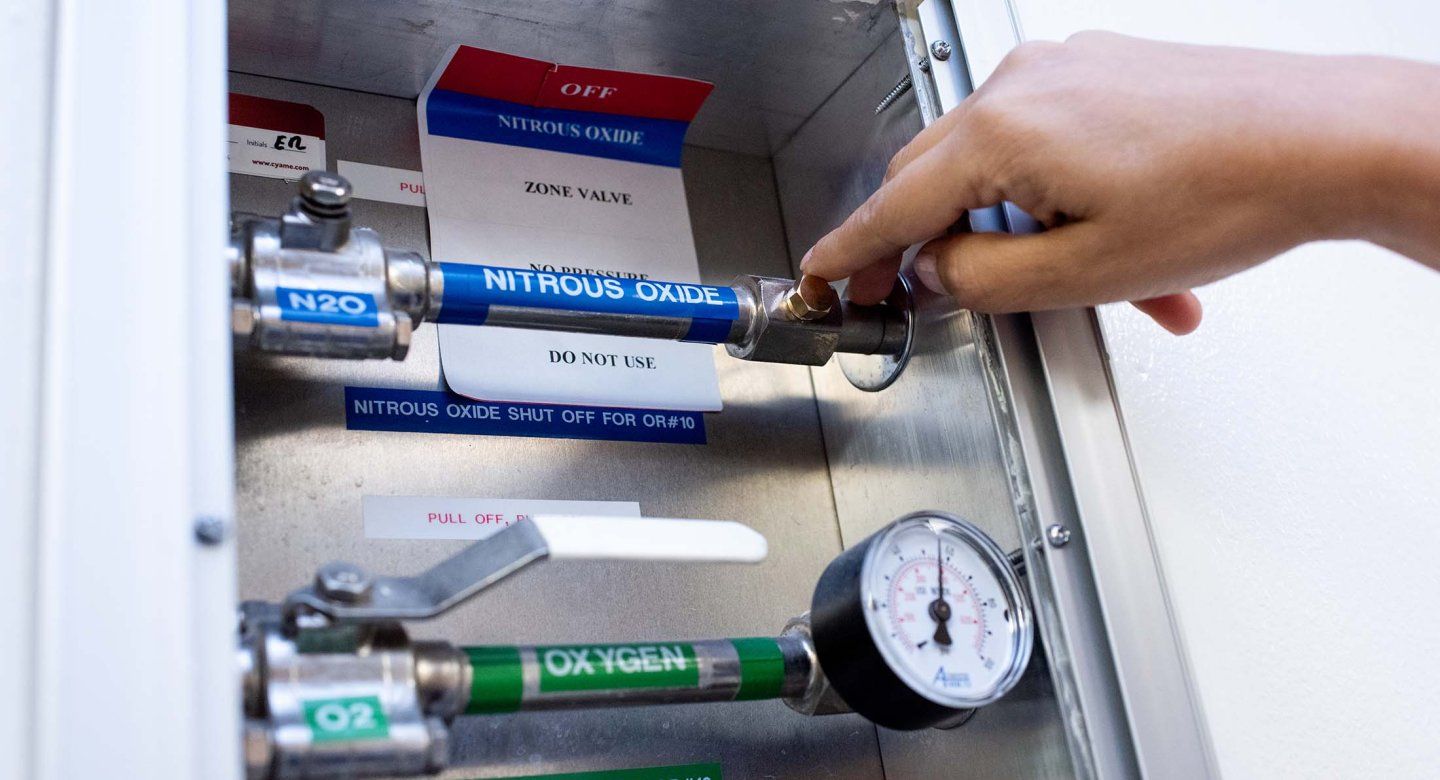UC San Francisco Sustainability Director Gail Lee, REHS, MS, HEM, sat before her laptop and clicked open a file. At first, it didn't seem like much. Just one of a dozen medical supplies purchasing reports she read regularly as part of tracking sustainability efforts throughout UCSF and its associated health facilities.
But then, something caught her eye.
The data was from 2021 during the COVID-19 pandemic. At the time, UCSF Health medical centers, like others, followed public health guidance to postpone non-emergency surgeries. Surgeries had plummeted but, looking at the report in front of her, it appeared that orders for the anesthesia gas nitrous oxide had not. That was odd.
“It seemed like we were still buying a lot of it – and right in the middle of COVID when we’d reduced elective surgeries,” remembers Lee, who also holds a U.S. Green Building Council LEED Green Associate certification in sustainability practices. “I thought, how can that be?”
She pulled UCSF Health purchasing reports for the last few years and, opening up her email, attached them to a message. She began to type.
“Seema, could you look into this? Why we are purchasing so much nitrous oxide even though we stopped elective surgeries?”
No surprise, a mystery
Modern anesthesia is a San Francisco invention. In 1962, UCSF Anesthesiology Professor Edmond “Ted” Eger II, MD, and colleagues developed the first dosing method. Still the gold standard today, Eger took the guesswork out of anesthesia by establishing the concentration of any gas needed to “put a patient under”.
But the ethers Eger made a career out of measuring are also potent greenhouse gases, trapping heat in our atmosphere like a thick blanket. In California, this fuels more frequent and deadlier wildfires and heat waves, for instance. Globally, health care makes up about 5% of greenhouse emissions. The U.S. churns out more of these emissions than any other nation.
It’s why UCSF Anesthesiology Professor Seema Gandhi’s fight against climate change began nearly a decade ago in the operating room.
What started as small pilot projects conceived of during long nights as the anesthesiologist on duty have blossomed into new ways of reducing anesthesiology’s greenhouse emissions. Today, Gandhi is UCSF Heath’s first medical sustainability director. The techniques she and colleagues have developed help UCSF prevent hundreds of metric tons of emissions a year and have saved the university millions of dollars. Her work to green her field is also helping other University of California campuses curb their emissions and is shaping anesthesiology care nationally.
So, it was no surprise when Lee reached out about the mysterious discrepancy between the number of surgeries and amount of anesthesia being purchased.
Why tackling emissions is part of quality care
Anesthesiologists often rely on a handful of gases to “put patients under.” Which gas they choose depends on a patient’s health and the surgery.
Take three of the most commonly used gases: sevoflurane, desflurane and nitrous oxide. An hour’s use of sevoflurane lets off about as much greenhouse emissions as an 18-mile commute from Orinda to San Francisco. Driving 200 to 400 miles produces about the same emissions as an hour’s use of desflurane. Nitrous oxide is particularly nefarious. It is nearly 300 times more potent than the most common greenhouse gas carbon dioxide, and also nibbles away at the ozone layer in the atmosphere, which protects us from some of the sun’s harmful rays.

“Some of the choices we make as anesthesiologists contribute to emissions and climate change, which affects the patients we swore to take care of," says Gandhi. “As a doctor, I took the Hippocratic oath, which says ‘Do no harm.’”
Pipes and plot twists
By 2019, Gandhi had already successfully advocated for UCSF Health to stop using desflurane widely, a move bolstered by research showing that most patients didn’t need it when other anesthetics were available. Today, UCSF’s decision to discontinue widespread use of desflurane is equivalent to taking 240 cars off San Francisco streets every year.
The majority of nitrous oxide was leaking and wasted. Some hospitals were losing up to 98% of the gas they were purchasing.
Around the same time, Gandhi and her colleagues developed a system to alert clinicians to sevoflurane overuse while in surgery: If doctors used too much or too high a flow, a bright yellow box popped up on operating room monitors, allowing doctors to dial back the flow unless medically needed.
So, in 2022, when the mysterious discrepancy caught Lee’s eye, she emailed Gandhi figuring she might have ideas.
Gandhi, it turned out, had been reading new studies on nitrous and saw a potential connection. As the COVID-19 pandemic dominated headlines, researchers globally began releasing startling findings about the gas. “Evidence was coming out that, even in state-of-the-art hospitals with the latest technology, the majority of nitrous oxide was leaking and wasted.” Gandhi says. “Some hospitals were losing up to 98% of the gas they were purchasing.”
Gathering a team, Gandhi decided to dig back into UCSF Health’s digital archives. They wanted to compare nitrous oxide purchases with clinical use over five years, from 2018 to 2022.
The work was long and tedious.
“We looked into our electronic health records system, which is the most granular, purest data we could get on how much nitrous oxide was actually delivered to the patient,” Gandhi says.
The case of the disappearing nitrous
By February 2023, she finally had an answer.
“Between 80% to 90% of the nitrous was never reaching patients,” she says. “There was no problem in the system, it was just the nature of the compressed gas.”

Hospitals store nitrous in large canisters in storage rooms. Pipes in the walls ferry the gas from these cylinders through facility pipes to operating rooms and, finally, to patients. Gandhi’s research confirmed what others were seeing: Nitrous was escaping at every twist, turn and nozzle.
In short? Lee’s blip in the data was the tip of the iceberg. It was a global problem.
Shut off valve
In San Francisco’s Western Addition neighborhood, UCSF’s Mount Zion Medical Center peppers six city blocks. Its glass and stucco buildings rise above sidewalk cafes and old Victorian homes.
Inside, Gandhi and UCSF sustainability analyst Kaiyi Wang walk down a long, white and brown hospital hallway, followed by a local CBS television news crew. The duo turn a corner and Gandhi reaches for her badge, unlocking heavy steel double doors.
Entering an operating room, Gandhi and Wang stop below a series of hoses dangling from the ceiling. The camera pans upwards. A green hose delivers oxygen to surgery patients, a white hose acts as a vacuum during procedures. One hose, a blue one, the newscaster explains, is missing.
Nitrous oxide.
Writing the next chapter: UCSF is first U.S. academic medical center to stem leaks
In June 2023, UCSF Health became the first academic medical center to shut down its nitrous oxide pipes for good based on Gandhi’s findings, switching to less leak-prone portable cylinders. The shift, captured by the television cameras, has reduced emissions by the equivalent of 2.69 million miles driven, or 340 trips around the Earth, and saved the university $1.2 million so far.
With the support of UCSF Department of Anesthesia and Perioperative Care Chair Michael Gropper, MD, PhD, Gandhi has worked with architects and planners to ensure new UCSF hospitals forgo piped nitrous infrastructure.
She is now creating a manual to help smaller health systems throughout the country do the same. Meanwhile, Gandhi’s low flow alert system for sevoflurane has been adopted at four other University of California health systems, including UCLA Health, UC Davis Health and UC San Diego Health – helping the University of California reduce emissions even further.
In October 2023, the American Society of Anesthesiologists unanimously endorsed the use of the lower doses of sevoflurane on which Gandhi’s alert system is based. The move paves the way for tens of thousands of anesthesia providers across the country to adopt Gandhi’s approach to reducing emissions from sevoflurane in their facilities. If UCSF’s pioneering discoveries of the 1960s penned modern anesthesiology’s introduction, Gandhi, her colleagues and UCSF anesthesiology trainees are writing its future. Today, no anesthesiology resident graduates without taking classes in environmental stewardship.
And in a world full of big problems like climate change, Gandhi likes to remember she started small.
“I began with pilot projects. Now those pilots have grown into programs used by hospitals across California and are shaping health care nationally,” she says. “One project can have a huge impact.”
“What I have learned in my journey of sustainability is that people want to do the right thing. Sometimes, they just need the tools to do it.”
